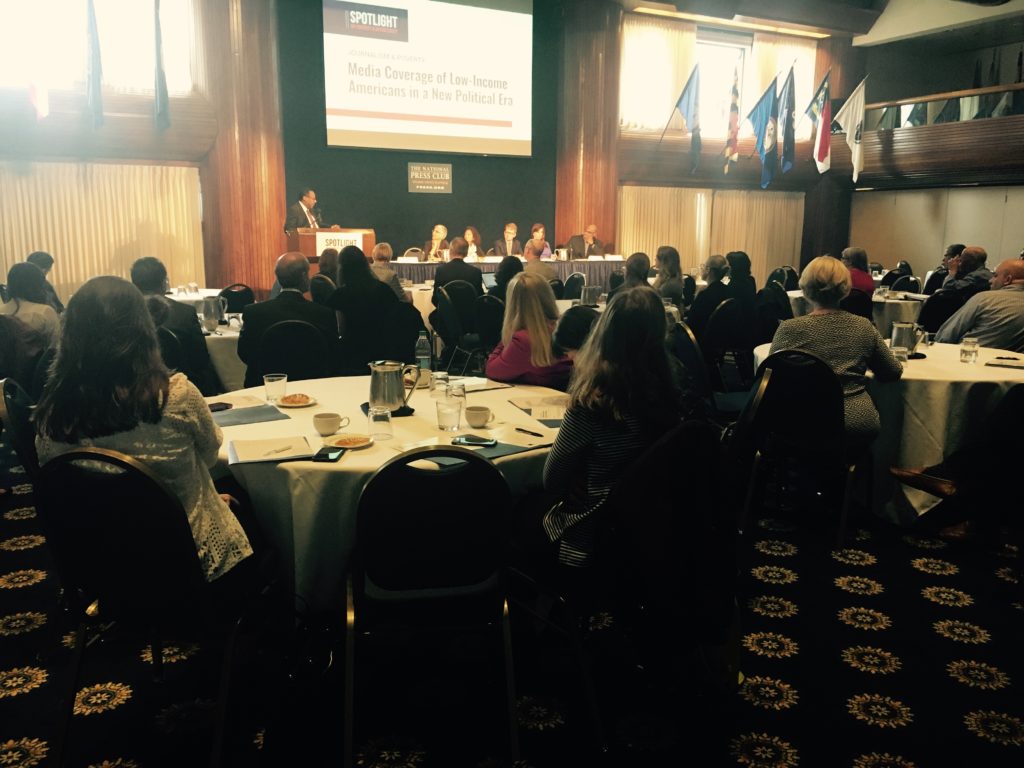Media Coverage of Low-Income Americans in a New Political Era
On Monday, Spotlight on Poverty and Opportunity celebrated its 10th anniversary with the release of a new study of trends in poverty journalism and a panel discussion about how journalists can increase and improve coverage of low-income Americans.
The event, held at the National Press Club in Washington, D.C., marked Spotlight’s growth and impact as a one-stop shop for poverty news and policy from across the political spectrum. The website, which launched in 2007, now features a growing poverty journalism initiative, more than 22,000 Twitter followers and more than 10,000 weekly newsletter subscribers.

The poverty coverage survey used a Nexis scan to compare—first in 2007 and then in 2016—the prevalence of articles containing the words “poverty,” low-income,” and “income inequality” in seven major news outlets: USA Today, The New York Times, The Wall Street Journal, the Los Angeles Times, the New York Post, the Chicago Tribune and The Washington Post.
The results show some positive developments, chiefly that the coverage of “income inequality” increased substantially in The New York Times and Washington Post, and saw more modest increases in the other outlets, save for The Wall Street Journal, where coverage remained stagnant.
Coverage centering on “poverty” and “low-income” showed more room for improvement, however. On “poverty,” stories increased only in The New York Times and Washington Post over the 10-year-period; the same two organizations, plus The Wall Street Journal, showed increases for mentions of “low-income.”
The study also raised concerns about the impact that the continued hollowing out of local journalism will have on poverty coverage. A look at the largest media organizations in each of the 10 states with the highest poverty rates found that none had a reporter assigned to cover poverty issues. That lack of coverage reflects diminished resources, but also choice. At the Jackson Clarion-Ledger in Mississippi, for example, six of the 29 editorial staffers cover sports. At Arkansas Online, there is no designated poverty reporter, but there is a sports recruiting columnist.
The panel discussion, moderated by Chicago Tribune syndicated columnist Clarence Page, focused on a series of principles the panelists agreed were key to successful poverty coverage.
- Use the income inequality lens widely: Vox Editorial Director Laura McGann said her organization tries to weave analysis of and reporting on the structural causes of income inequality into all of its journalism. “There’s a huge number of people who come to our site because they care about income inequality,” she said. “This is not an add-on for us; it’s at the core of our business model.”
- Policy coverage is on the rise: Several panelists voiced hope that the rise of journalism focused on healthcare, technology, and other policy topics will lead to more reporting resources devoted to poverty. “Policy journalism is now stronger than at any time in my lifetime,” said Sam Baker, Healthcare Editor at Axios.
- Context is crucial: There was wide agreement that journalists who “parachute” into communities for stories have to work harder to understand their subjects and the particular socioeconomic, geographic, and historic forces that play out in their lives. “A lot of the time we hold people up for ridicule or sympathy, and they don’t want either. They want to be understood,” said Jesse Holland, the race, ethnicity, and demographics reporter for the Associated Press. “We will often portray people as either moochers or victims . . . when you paint things in these really black and white ways, it’s hard to get the context,” said Marisol Bello, Director of Content Strategy and Development for the Center for Community Change and former reporter at USA Today.
- Poverty is a bipartisan problem that requires bipartisan solutions: Journalism about poverty too often relies on party stereotypes that paint progressives as having the most concern about the least fortunate. “Right and left do differ in the values they bring . . . but the debate is often portrayed as if the people on the center left have a monopoly on answers. I think there are a lot of people on the center right who really do care,” said Tamar Jacoby, president and CEO of Opportunity America and a former journalist at The New York Times and Newsweek.
You can watch the full video of this event here.
